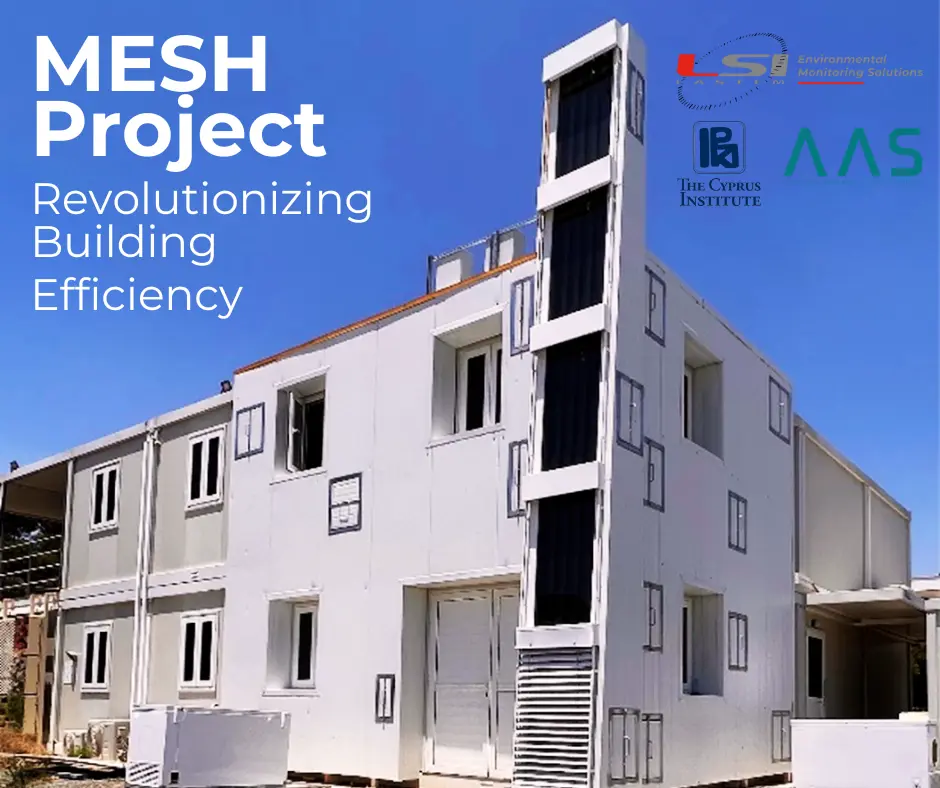As the demand for sustainable and energy-efficient buildings intensifies, innovative solutions like the MESH project are leading the way towards a greener future. At LSI LASTEM, we are proud to contribute to this groundbreaking initiative with our advanced environmental monitoring sensors, which play a crucial role in the project’s success.
Revolutionizing Building Efficiency with the MESH Project: The Role of LSI LASTEM’s Environmental Monitoring Sensors

Understanding the MESH Project
The MESH (Nature-inspired Modular and Flexible Skin for High-Efficiency Buildings) project is an ambitious follow-up to the FLXiLight innovation experiment, conducted under the H2020 SmartEEs Innovation Action (ICT-04-2017). This project addresses the pressing need for energy-efficient buildings, which account for 40% of energy consumption in Europe. The European Union’s Green Deal aims to double the current renovation rate, targeting energy efficiency for over 80% of the building stock by 2030.
MESH introduces a holistic approach to building design and construction, integrating state-of-the-art materials, design methods, and fabrication processes. This adaptive cavity facade system enhances thermal performance, making buildings more resilient to environmental stress and significantly reducing energy consumption.
AAS and The Cyprus Institute: The Visionaries Behind MESH
Adaptive Architecture Systems (AAS) (website), a start-up founded in 2021 in Cyprus, and The Cyprus Institute, a non-profit research and educational institution with a scientific and technological orientation, are the creative force behind MESH.
AAS focuses on developing data-driven retrofit solutions aligned with the United Nations Sustainable Development Goals (SDGs), aiming to create enjoyable, sustainable, and resilient living spaces.
The Cyprus Institute plays an important role in modelling the building behaviours and analysing the data coming from the pilot building in order to evaluate the functionality and efficiency of the AAS’s solution. The innovative solutions coming from the MESH project are crucial for achieving climate neutrality, addressing urban heat islands, high energy consumption, poor energy performance in existing buildings, and the escalating impacts of climate change.
The Pilot Building in Cyprus: Showcasing MESH’s Impact
A key demonstration of the MESH project’s capabilities is the pilot building in The Cyprus Institute Campus. This building serves as a live case study for the innovative adaptive facade system, highlighting its potential in real-world conditions.
The existing building, which hosts laboratories and offices, has been renovated with the MESH adaptive facade, to test the improvement of its thermal and energy performance. This facade system is designed to respond dynamically to environmental changes, enhancing indoor comfort while reducing energy consumption, it is based on the chimney element that helps to remove excessive heat from the building by naturally forcing air flow inside the ventilated facade.
The building behaviour was simulated via software and the installation of sensors is now testing the efficiency of the adaptive cavity facade comparing the real response to the simulated result. The verification process will last one entire year in order to study the behaviour in the summer and winter seasons.
This pilot project underscores the importance of combining advanced environmental monitoring with adaptive design to create resilient, smart buildings. It paves the way for broader adoption of such technologies, contributing significantly to the EU’s Green Deal goals and the global push towards climate neutrality.
The Role of LSI LASTEM’s Environmental Monitoring Sensors
LSI LASTEM environmental sensors have been installed in the MESH pilot building, mainly in the chimney and in the facade gap in 19 measurement points, providing the necessary data to optimize the adaptive facade system’s performance. Here’s how the sensors contribute to the project’s success:
- Real-Time Environmental Data Collection:
The sensors continuously monitor various environmental parameters such as air and contact temperature, humidity and wind speed with hot wire anemometers. This real-time data is crucial for the AI-driven design operation of the MESH system, allowing it to adapt dynamically to microclimate changes.
- Enhancing Thermal Performance:
By accurately measuring the building’s thermal conditions, the sensors help fine-tune the facade system to maximize energy efficiency. This adaptive response not only reduces energy consumption but also enhances indoor comfort for occupants.
- Supporting Climate-Sensitive Design:
The integration of sensors enables MESH to respond to local climate conditions effectively. This climate-sensitive performance ensures that the facade system operates optimally throughout different seasons and weather patterns, contributing to long-term sustainability.
- Facilitating Data-Driven Decision Making:
The comprehensive environmental data collected by the sensors empowers architects, engineers, and building managers to make informed decisions regarding building design and retrofit strategies. This data-driven approach ensures that each MESH installation is tailored to its specific environment, maximizing its impact.
A Step Towards a Sustainable Future
The MESH project represents a significant leap forward in the quest for sustainable and energy-efficient buildings. By leveraging advanced technologies and smart materials, it offers a transformative solution to the pressing challenges of urban heat islands, high energy consumption, and climate change. At LSI LASTEM, we are honoured to play a vital role in this initiative.
As we look towards the future, the collaboration between innovative projects like MESH and advanced sensor technologies will be crucial in driving the transition towards climate-neutral cities. Together, we can create a built environment that is not only energy-efficient but also resilient, sustainable, and enjoyable.
